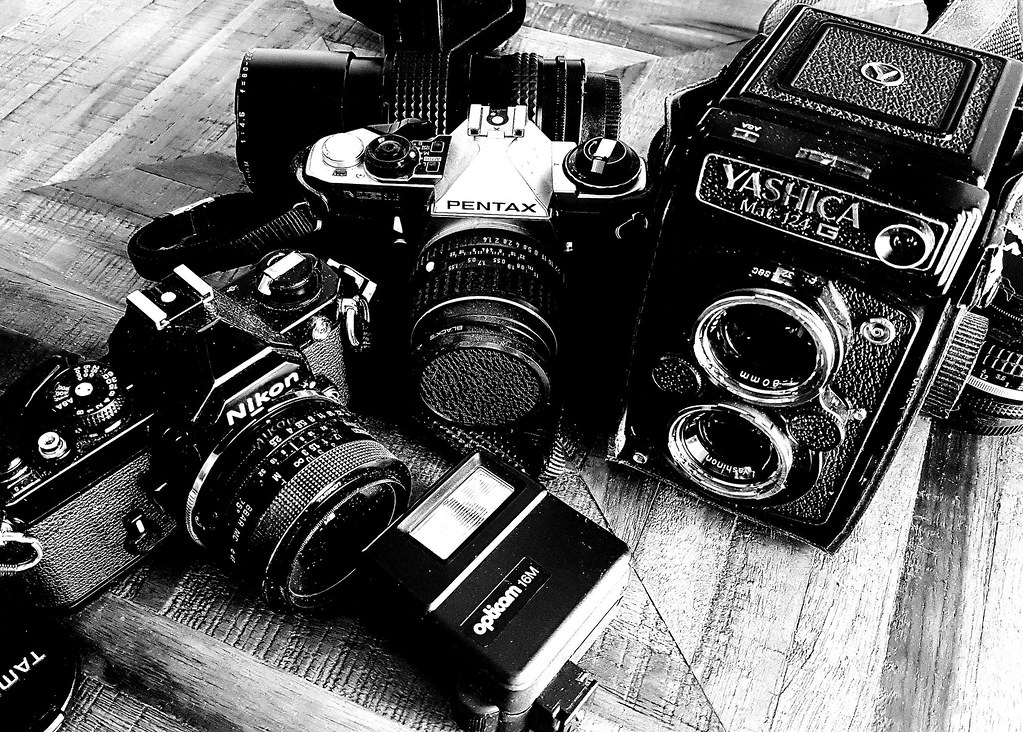35mm, Medium Format, and Large Format Film Photography

Photo by Jason Thibault. Licensed under CC BY 2.0
Whether you’re starting with 35mm film cameras, medium format cameras, or large format cameras, the various film sizes can be found in color print film, black and white film, and color reversal film.
Guide to Photography 35mm Film Size
35mm film is the most popular film photography type. 35mm film, or 135 film, was introduced by Kodak in 1934. Fitting 35mm cameras, including single-lens reflex (SLR) and range-finder cameras, basic 35mm film photography is named after the size of the film – 35mm wide. Individual rolls of 35mm film are enclosed in a single-spool, light-tight, metal case that allow it to be loaded into cameras in the daylight. Therefore, when the roll of film is used, it must be re-wound back into the spool before opening the camera. In the case of disposable cameras, the film is kept in a light-tight casing until opened by a lab technician in the dark. Both sides of a 35mm roll are perforated to allow mechanisms within the camera to advance and rewind it.
The standard image size on a 35mm film roll is 24 x 36 mm with a perforation size of KS-1870. This standard ensures that the film properly advances eight perforations to allow a two millimeter gap between frames and eliminate overlapping of images on the film. Of course, there are other 35mm film types that have different image sizes, but these are rare and will likely only be found in specialty stores. The 35mm film standard will be found in any common convenience store and all camera shops. Most 35mm film is found in 24-exposure or 36-exposure counts. However, with most cameras and proper film settings, you will be able to squeeze out an additional two or three photographs.
Basic Photography Tips for Medium Format Film
Medium format film is much larger than the 35mm counterpart, and is preferred by many professional photographers. Of course, due to the size of medium format film, a medium format camera will be needed to use it. Most often, medium format film is 6 x 6 cm square or 6 x 4.5 cm rectangular (commonly referred to as 645). Today, medium format photography utilizes the 120 film format and, in some cases, the 220 film format. These formats are nearly identical except that 220 film is twice as long and allows twice the number of exposures. With 120 film, you can get either 12 or 16 exposures and double that amount with 220 film. Medium format film is still readily available at most camera shops and online distributors.
There are no perforated edges to medium format film, but instead the camera takes the film from one spool to another. When the roll is finished, the roll wraps around the second spool, making the film light-tight, and allows the photographer to open the camera and remove the film. There will also be a sticky tab that can be used to tape down the film and prevent it from unrolling. Additionally, the film will now be labeled exposed to indicate that the film has been used and is ready for processing.
Large Format Beginner Photography Film Tips
Large format film works a little different than both 35mm film and medium format film as there are no spools used. Instead, large format film is individual 4’x5’ sheets that are loaded into a special film holder that locks into the back of a large format camera. The holders will hold two sheets of film on both sides, and must be loaded in the complete dark. When loaded into the back of the camera, the light protective sheet is removed and will allow you to release the shutter and expose the film. The protective sheet is then returned to the holder before your film is removed. The film will remain in the holder until ready for development.
















